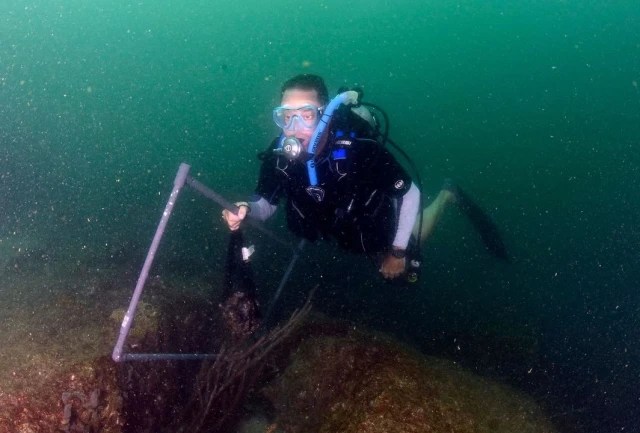
The Mochima National Park is popularly known for its islands with crystalline waters and white sands, but its seabed hides a silent enemy that threatens its biodiversity.
By La Patilla
Jan 29, 2023
The most worrying thing is that there is a danger that it will invade the entire Venezuelan coast.
The terror of conservationists is a coral from Indonesia called Unomia Stolonifera, which was introduced by an exotic species dealer.
It could destroy a preserved space which is shared by the states of Anzoátegui and Sucre, that has been set apart for the protection of an endless number of species and also harm tourism.
At first glance it appears to be a vegetation carpet in the background; up close it resembles a cabbage.
You might think it’s an algae, but it’s really a soft coral, which propagates rapidly and destroys native species.
Here are some clues that help identify the problem, which already covers more than 50% of the seabed in this national park.
* Its origin is Indonesia, specifically from the Indo-Pacific. It is a soft coral, classified as invasive due to its rapid expansion and invasion of any virgin are or coral reef.
It is damaging because in the Caribbean there are no predatory species of this type of coral, which allows for its rapid development and, therefore, the destruction of local species.
* The scientific team of the Unomia Project explains that it was illegally introduced between 2000 and 2005 by a trafficker of exotic species, presumed to be Asian.
* The so-called ground zero was Valle Seco, in Anzóategui State. There, this dealer of exotic species and corals for fish tanks released the first Unomia Stolonifera.
In this place, a fish farmer allegedly observed for the first time what he thought was a plant that he began to collect to sell it to specialized stores in saltwater aquariums, as an ornament, but experts say that by cutting it, there is a risk of furthering the proliferation of the invasive species.
* Unomia’s growth was immediate. So much so that it is already cataloged by the Unomia Project as a “worrying ecological disaster.”
Mariano Oñoro, coordinator of the Unomia Project, lamented that the rapid growth of coral is destroying native biodiversity.
“It should be noted that there are recoverable areas and others that are not, but they can be controlled to prevent further expansion.”
* By November 2021, the Unomia Project estimated that more than 50% of Mochima’s coasts were already plagued with this coral.
* Unomia Stolonifera, when invading an area, kills or endangers the native coral species of Venezuela.
The same happens with all the fish and organisms that live among these displaced corals or grasses.
Impact on Fishing
There are hundreds of fishermen who live off Mochima’s biodiversity, but Unomia posits their livelihood is at risk because “spawning spaces are being lost, the fingerlings (newly hatched fish) do not have their natural feeding and development areas, which are like their nurseries to grow,” pointed out a fisherman from the area.
When the problem began, some fishermen began to remove the coral manually, which could have contributed to its proliferation, due to ignorance of how to deal with this problem.
Once this coral became known, the Tortuga Foundation and the Unomia Project began to train them for the treatment of the invasive species.
“We are afraid that this will leave us without a park, without a sea, without fish, because we have to stop this, which we did not know was so dangerous,” says Luis Medina, a local fisherman.
Answers To The Problem
During a press conference on tourism, the Governor of Anzoátegui State, Luis Marcano, reported that “specialized commissions from the Ministry of Ecosocialism (Minec), together with environmentalists, are dealing with the problem and traveling to the affected zones to find a solution.”
Since June 2021, the ministry would have started a care plan for the problem that little by little has been spreading throughout the entire Venezuelan coastal axis.
These would be some of the measures that are being applied in affected areas, taking Arapo Island as a sample.
To remove this coral, the area is being cleaned using a manual removal method.
The Minec works in this area of Isla Arapo because there are corals that are more than 300 years old.
This foreign coral species has colonized 50% of the Mochima National Park, affecting the native coral banks and in turn, the fishing areas, where this important economic activity for Venezuela takes place.
The Ministry of Ecosocialism is implementing measures to protect native corals and the fish that live there.
Ecologists warn that this work must be permanent and non stop, because if it is not carried out almost daily, oxygen is given so that the species can multiply and repopulate areas “that have been cleaned up”.
Research In Other Areas
The Tortuga Foundation and @unomiaproject follow up and monitor this problem, recently they have responded to complaints of the invasive coral’s expansion that fortunately were negative.
“After a long wait due to the storms and tropical waves that have been occurring in recent weeks, we were finally able to meet the monitoring objectives on La Tortuga Island,” they posted on their account @unomiaproject
If you want to know more about this coral and the Unomia Project, we invite everyone to follow the Instagram profile @unomiaproject.
…
Read More: La Patilla – Unomia Stolonifera, a silent enemy that threatens to devastate the marine ecosystem of Venezuela
…

